Do you know what link pyramids are in SEO?
If you’ve started to get into link building for your website, you might have come across this concept.
First off, you should know that when we talk about link building strategies, such as Tiered Link Building, we’re venturing into the world of Black Hat SEO.
But, even though these techniques always carry a risk, there are ways to do it that can be less obvious to the eyes of Google.
In this post, we’ll look at what link pyramids are and how they can benefit your projects. I’ll also show you how I would set up a pyramid in 2024 to make it efficient and also reduce the chances of being penalized by Google.
What Is Tiered Link Building
Tiered Link Building, or a link pyramid, is a SEO technique for creating external links (backlinks) where these are categorized into different levels based on their characteristics.
The concept is as follows:
- Each level (or tier) exclusively links to the immediately higher level and never to the rest.
- As you go down from one level to another, the number of links increases while their quality decreases.
Thus, the links from Tier 3 point to the pages in Tier 2, Tier 2 to Tier 1, and so on up to the highest level where our main website is located.

The ultimate goal of this entire setup is to optimize the distribution of link juice through the pyramid so that the strength of each page is passed on to the higher levels, increasing the authority of the website at the top and, consequently, its visibility in search engines.
What Are the Advantages of Tiered Link Building?
Building a link pyramid is a strategy that, if done right, can give a good boost to your website’s ranking.
But, as I say, it needs to be done correctly. And that requires time and dedication.
So, is all the effort worth it? Wouldn’t it be better to just create backlinks to our website and forget the hassle?
Everything will depend on your resources and the characteristics of your project. Therefore, to help you decide whether or not this strategy is right for you, here are the main benefits you can gain:
- Increased authority of your website and its ranking. Distributing link juice through the tiered pyramid transmits all the strength of the links to your main website.
- Control over your links. You know exactly which pages are linking to each other and what their quality is, allowing you to make more informed decisions.
- Money savings. On the lower levels, you can use lower quality links, meaning they’re cheaper or even free.
- Greater protection against Google penalties. The Tier 1 links pointing to your website are of high quality, making it unlikely they will harm you. If Google decides to penalize any links from other layers (Tier 2 or Tier 3), your website will not be directly affected.
Do tier backlinks still work in 2024?
The quick answer is YES. Even today, backlinks remain a ranking factor for Google, and therefore, link pyramids are still useful.
However, to be more specific, it must be acknowledged that their results are not as efficient as they were in the past due to the evolution of search engine algorithms.
Evidence of this is the Spam Update that Google rolled out in March 2024. Among its goals is to eliminate low-quality pages that use artificial backlinks to manipulate their authority.
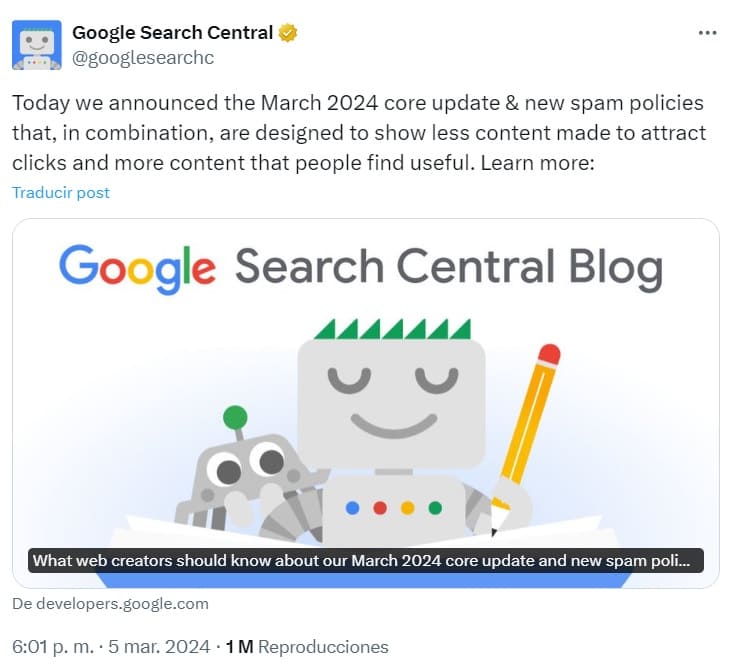
For this reason, although link pyramids are still operational currently, much more caution is required than in past years.
We must move away from link farms, automated techniques, or cheap backlink packs from Fiverr and focus on designing a solid strategy where the links at each level truly make sense and add some value.
What are the disadvantages of a link pyramid?
Earlier we discussed the advantages of Tiered Link Building, but obviously, there are also potential drawbacks you should be aware of. Here are the main issues with setting up a tiered linking:
- High time investment. This strategy requires a lot of dedication to find the right sites to place a link, properly classify them, and create content that will include the backlinks.
- Potential Google penalties. Although well-executed tiered link building is supposed to protect your website, it’s quite easy to slip up and get caught by Google.
Tier Link Structure
Are you intrigued by this tiered link building strategy and want to know how to implement it?
Don’t worry, up next I’ll explain it to you in the most practical way possible, highlighting those aspects that I would focus on today to ensure that the pyramid works and to minimize the risk of being penalized by Google.
Main website, business or money site
The money site refers to the website of your project or business. It’s the site we want to rank and to which we will transmit all the linking power.
But for our tier backlinks to work, we must first be concerned with optimizing the internal links of our website. There’s little point in designing a link building strategy if we don’t know how to distribute authority among the pages of our site.
With DinoRANK, you can easily analyze the internal linking of your website and discover how PageRank is being distributed among your pages.
For example, here are the charts that the tool shows for DinoRANK’s own domain:
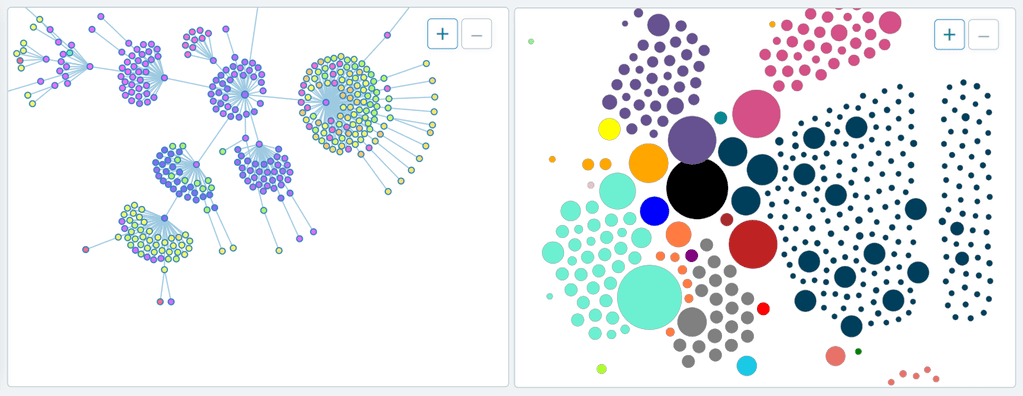
At a quick glance, we can check if the most crucial pages are getting more PageRank (larger circles) and if there’s any significant URL left unlinked.
Have you looked over your website’s internal linking?
So, now let’s get down to business and start designing our Tiered Link Building campaign.
Tier 1 Backlinks
The first level of the pyramid is the most important part of the whole strategy and should be given the utmost care. It consists of all the pages that link directly to your money site, and for that reason, any mistake can have drastic consequences on your ranking.
Here, we will always use websites related to our niche, preferably with high authority and featuring original, high-quality content.

Some recommended sites for these types of links include:
- Guest posts on well-known blogs within our industry.
- High-authority news outlets that aren’t link farms.
- YouTube channels that cater to our audience.
In general, tier 1 backlinks are the most difficult to obtain and will take up most of our time. Usually, we will be the ones writing the content for the link or, at the very least, reviewing the articles before they are published. This enables us to ensure they are of sufficient quality for our purposes and use an appropriate anchor text.
Tier 2 Backlinks
The second level of the pyramid includes all those web pages that link to the URLs of Tier 1. In other words, they will never link directly to our money site, only to the pages on the first level.
Here we can start to relax the quality of the sites and their content a bit. But just a bit. After all, we are linking to pages that contain backlinks which were difficult to obtain and that we don’t want to end up penalized.
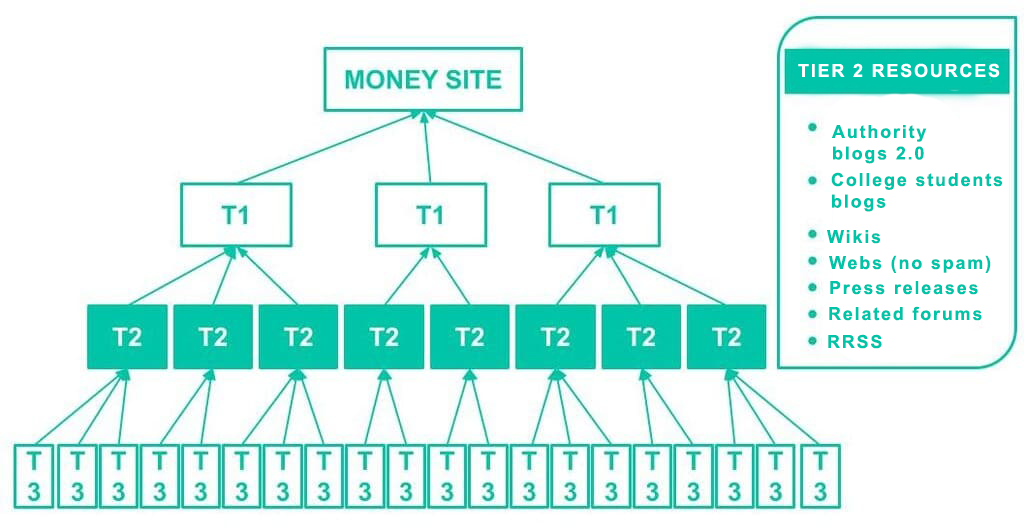
Some examples of sites for this level include:
- Blogs 2.0 on authoritative platforms like Blogger or WordPress.com.
- University blogs.
- Wikis.
- Websites on link-buying-and-selling sites that aren’t too “spammy”.
- Press releases from authoritative sites.
- Forums highly relevant thematically to the link.
- Active profiles on social networks such as Twitter, Pinterest, or Facebook.
As you can see, these links are easier to obtain and work with. Moreover, we could use AI to generate content and speed up the process, as long as we check the final quality of the result.
Lastly, if you read other articles about link pyramids you might notice that some of the sites I mention here are also recommended for Tier 1.
Keep in mind that many of these posts are a few years old and that in 2024 Google is quite more cautious about certain types of links. That’s why I prefer to err on the side of caution and reserve them for Tier 2, leaving the first level for those backlinks that give me greater assurance.
Tier 3 Backlinks
Now we reach the last level of our pyramid, which is also the most aggressive part of our strategy.
From here we link exclusively to Tier 2 pages and prioritize quantity over quality. The goal is to create a large number of links that strengthen the URLs of the second level and also help with their indexing.
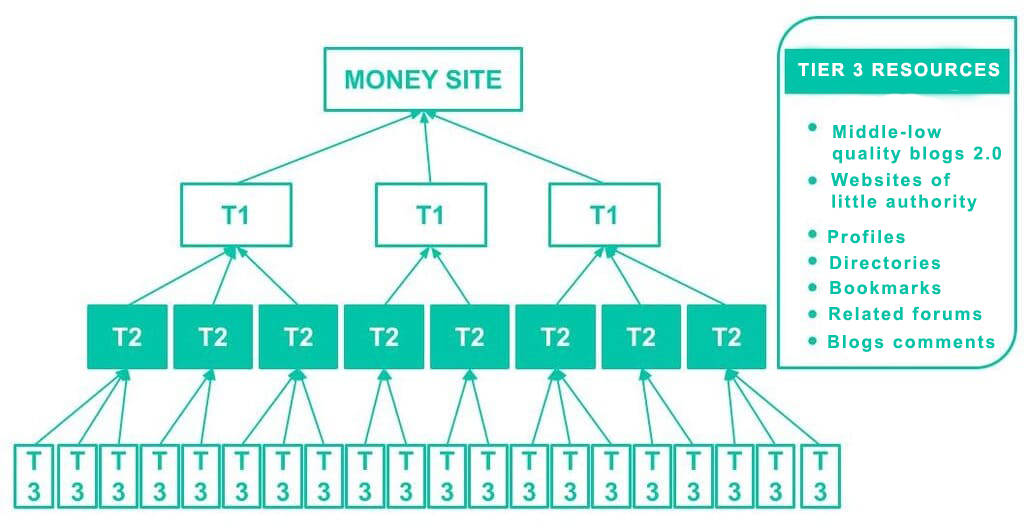
Therefore, for Tier 3, the following are commonly used:
- Blogs 2.0 of medium-low quality.
- Websites on link-buying-and-selling sites with low authority.
- Profiles.
- Directories.
- Bookmarks.
- Forums.
- Blog comments.
There are other more Black Hat techniques that I do not recommend using, such as automated backlink generation tools, link shorteners, or pages of dubious reputation.
These tactics may have worked in the past, but Google is becoming better at recognizing these types of backlinks and, in the best-case scenario, will ignore them. In the worst case, it could penalize them and ruin your entire strategy in an instant.
Conclusions on Tiered Link Building
Tiered Link Building is a technique that still works today and, when executed properly, can give a boost to your web project.
However, the risks are evident. You’re playing against Google’s policies, and therefore, the possibility of receiving a penalty is always there.
That’s why, if you decide to employ these kinds of SEO strategies close to Black Hat, I advise you to proceed with extreme caution.
In this article, I’ve shown you several keys to setting up a link pyramid with a good chance of success in 2024.
If you’re up for giving them a shot, I recommend trying them out on a website you’re just starting, never on your main project. This way, you can assess their impact more calmly and decide if it’s the right technique for you.

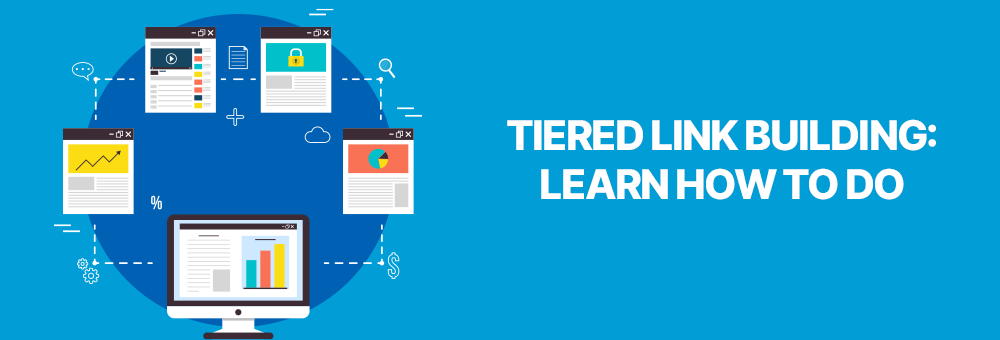
2 comments
Okinawa
Hi Dinorank,
So I’m running my online business since 5 months ago and do a lot of research about SEO world, then I found out that to be able to rank on Google turns out to be very complicated but the scenario is very challenging.
A simple domain contains many components that drive some factors to rank, like Backlinks, DA PA, Anchor Text, Spam Score, Domain Age, Citation dan Trust Flow, 301 redirect, etc.
Then I see a video on Youtube that teach how to pyramid backlinks and found some of my competitors doing the same!
So through this email, I’m interested to learn from you about pyramid backlinks properly.
Please let me know if You are willing to teach.
Thank you.
Ismael Ruiz
Hello Okinawa, we at DinoRANK are always willing to teach SEO through our Blog and our Wiki section. I hope you can learn a lot from the contents of our website 🙂